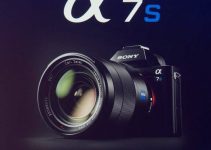A revolution in cinematography is on the horizon, one that will not be driven by tools, crews, or budgets but by the sheer creativity of the operator, using nothing but their hands and minds to breathe life into their imagination.
We’ve seen glimpses of that future here and there, with smart autofocus systems, widespread adoption of raw recording, and light field technology demonstrations, but now we’re one practical step closer to the inevitable future of computational cinematography.
Master of creative DIY camerawork, Brandon Li takes us on a guided tour of how we can potentially ditch some of the devices that are holding us back and achieve astonishingly smooth, stable footage while shooting handheld on a Sony A7sIII thanks to gyroscopic stabilization.
We’ve covered Brandon Li’s amazing DIY rigs in the past. They may seem to defy logic, but they produce some absolutely stunning results. If you haven’t subscribed to Brandon’s channel, you’re doing yourself a disservice – he is a super creative dude, and his videos are outstanding.
GYROSCOPIC STABILIZATION
Gyroscopic stabilization is post stabilization that is aided through recorded camera positioning information that is stored as metadata in the clips you capture. It is currently available in the Sony A7sIII, ZV-1, FX-9, and RXO II.
Since this post stabilization method doesn’t rely on the computer to track the objects in the frame and make a best-guess to determine how to smooth out shaky footage, it is faster, highly more accurate, and presents less weird artifacts like the ones we see with the Warp Stabilizer in Premiere Pro. Information from the gyroscope, inside the camera, is recorded along with your images and you determine how stabilization is applied after the fact.
HOW IT WORKS
Firstly, to use this system you have to turn off all in-body stabilization, and shoot at the highest shutter speed possible to avoid motion blurring. Typically we want to shoot at a shutter speed that is twice our frame rate, so this is a drawback in terms of how the motion in our footage will look.
Shoot some footage, and load it into your system as usual then launch Catalyst Browse.
Clips with a shaky filmstrip icon next to them contain the necessary metadata to stabilize the footage in this method. If there is no icon next to the footage, there is no metadata recorded with the file.
Select the clip you want, set in/out points as needed, and click stabilize.
By default, the software will zoom all the way in, over stabilizing the footage. Just click the “i” icon in the upper-righthand corner to adjust. This will open your crop factor settings and allow you to zoom out.
Zoom out until you start to see the shake reappear, then zoom back just far enough o eliminate it. Less shake means more crop, and more crop means a loss in resolution.
That is essentially it. The Catalyst Browse software is very barebones and intended strictly to process this metadata. I hope that in the near future we’ll see plug-ins for Premiere Pro, but as of right now this is how it is done if you’re looking to get some amazing results.
TRADITIONAL STABILIZATION METHODS
If you’re wondering if this ‘extra step’ in stabilizing your footage is worth it or if you should just stick with the usual methods, skip ahead to 3:28 in Brandon’s video to see some comparisons that might make your jaw drop. *I’ll summarize briefly below.
- Compared to warp stabilizer
- Warp stabilizing produces artifacts that sometimes look cool and sometimes look totally bizarre, but the catalyst system is perfect because it’s using recorded metadata. It isn’t guessing, it’s using facts and information.
- Compared to steady shot
- SteadyShot can sometimes work well with forward and backward movement, but when rotation is added it doesn’t handle it well at all. Gyroscopic stabilization smooths out all the bumps with linear motion, and rotation to produce a shot that looks a whole heck of a lot like it was filmed on a steadicam.
Alongside A Gimbal
3-axis gimbals are pretty amazing, and do a really fantastic job canceling out the operator’s motion, but typically just with wider lenses. Slap a telephoto lens on the camera, and tiny vibrations are going to be present in your footage (depending on the gimbal).
A lot of DPs take out those extra jitters with Steadyshot, but opting to use gyroscopic stabilization instead can produce otherworldly results.
Running at full speed, Brandon is able to capture incredibly smooth, steady shots with an 85mm lens!
Torture Test
To put the system through its paces, Brandon went for the most unstable step up he could – camera, on a gimbal, on a monopod. Fully extended, the monopod amplifies the operator’s steps. It would be an amazing way to shoot, but the added shaky usually makes the material unusable. Can the catalyst software smooth it out?
Unfortunately, gyroscopic stabilization alone can’t cure what ails this setup. But with a little added warp stabilization in post, Brandon is able to turn this shot into something fairly usable.
Is this the future?
Well, no. It’s not. This is the present.
I expect this technology to improve greatly overtime, and hopefully wind up in every camera as standard. This is a fantastic alternative to the incredibly slow, and often distorted warp stabilization method and in a pinch it definitely seems to put my gimbals in check.
With the added advantage of being able to use this for macro shooting, where warp stabilizing is often impossible, and knowing that it works on cool trick shots like the horizon roll, I could see myself and everybody using this in conjunction with other systems.
There are definite drawbacks to the loss of resolution by cropping to stabilize, and the higher shutter speeds required to lessen motion blur.
I do believe that this is invaluable technology that will hopefully detract from the massive surge in gimbal use we’ve seen over the last decade. So many DPs are reliant on their gimbal that has almost taken over their whole identity and locked them into a formula.
Hopefully, gyroscopic stabilization will give them the freedom they need to expand, grow, and provide post with a little bit more than just tracking shots, and parallax close-ups.
[source: Brandon Li]
Order Links:
- Sony Alpha a7S III Mirrorless Camera (B&H, Amazon)
- Sony PXW-FX9 XDCAM 6K Full-Frame Camera System (B&H, Amazon)
- Sony ZV-1 Digital Camera (B&H, Amazon)
- Sony Cyber-shot DSC-RX0 II Digital Camera (B&H, Amazon)
Disclaimer: As an Amazon Associate partner and participant in B&H and Adorama Affiliate programmes, we earn a small comission from each purchase made through the affiliate links listed above at no additional cost to you.
Claim your copy of DAVINCI RESOLVE - SIMPLIFIED COURSE with 50% off! Get Instant Access!




